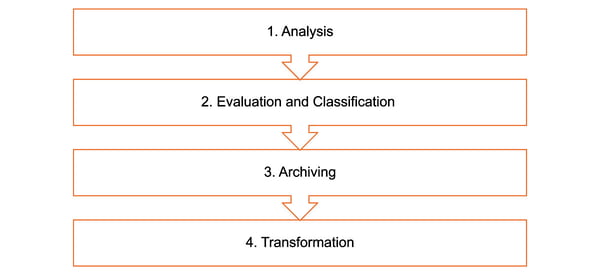We take a structured approach to archiving and transformation so you can keep track. With our innovative BCC process model, we migrate your data in just four steps.

We take a structured approach to archiving and transformation so you can keep track. With our innovative BCC process model, we migrate your data in just four steps.


IIn the first step of the process model, we analyse the existing Domino applications.
We use the BCC Analyser to read all Notes applications, determine the number, the owners and evaluate the user behaviour - are there still many accesses to the application? Who is accessing it?
We analyse the attachments - are there any attachments? If so, how many? What form and format are they in? Are they corrupted or encrypted?
Finally, the BCC Analyser provides you with a detailed evaluation via a Notes database, an SQL table or in Excel or Power BI.

IIn the next step, we evaluate the data together with you and make a recommendation for action. We use the Gartner TIME model as a guide and categorise your data as follows:
T: Tolerate
Data that you want to keep and continue to use operationally. For example, you can use this data with HCL Nomad via the Notes browser. The use of HCL Nomad requires an update to Domino 12. Nomad ensures that your Notes applications can be operated operationally and functionally in the browser, that workflows work, views and documents are available as usual and authorisation procedures continue to work. And all this without a Notes client.
An exciting solution for all those who have already migrated their Notes mail databases and are now using Microsoft Outlook. And who only need a Notes client to operate the Notes applications.
I: Invest
M: Migrate
E: Eliminate
This category includes data that must be retained to comply with regulations and guidelines (e.g. legal retention periods) and which you still need to access for information and research purposes. For this "historical data", we recommend archiving in HTML or PDF, for example.
Data that is redundant or no longer required for legal or other reasons can also be permanently deleted. werden.

Once the data has been analysed and evaluated, step 3 follows: the archiving of data that is not to be actively reused but must be retained for information and research purposes or to comply with regulations and guidelines.
To do this, we read out the Domino catalog.nsf, configure the archive jobs in the application and carry out the archiving according to the parameters you have selected.
Once archiving is complete, you will receive a detailed archiving log with all the relevant information..

You can also transform your data and use it in new operational target systems.
ActiveArchive offers you great flexibility in the choice of target systems and formats. We transform your data, including document details, file attachments, metadata, access rights and retention periods, into Microsoft SharePoint folders and lists or SQL tables according to your requirements.
The transformation is often accompanied by a functional redevelopment of the future application. Popular solutions are low-code apps such as Microsoft Power Apps or Mendix. We support you in selecting and developing the right solution and ensure that your data is accurately transformed into the new target systems.
Customers
BCC MigrationEngine makes just that possible. Our industry-leading tool empowers you to take control of your data migration journey, offering a selection formula that lets you handpick and tailor your migration precisely to your needs. Explore a migration experience that puts you in the driver's seat – because when it comes to your data, precision matters.
With it’s easy to use browser interface, BCC ActiveArchive for HCL Domino archives any HCL Notes applications and converts them into a browser-compatible format.
Join the BCC newsletter and be notified about important news, upcoming events, and more.